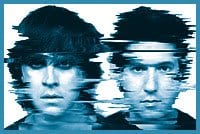In late November of last year, three friends and I drove through the night from Toronto to New York City to see the band Fischerspooner play a sold-out show at Irving Plaza. We had heard the myth of these glamorous art-punks whose live shows were said to incorporate robot costumes, complex choreography, hair extensions and huge exploding hearts. Fischerspooner is represented by the prestigious Deitch Projects art institution and has a four thousand square foot rehearsal space and, sometimes, a turban designer who tours the world with them.
We’d rocked out a million times last summer to Fischerspooner’s electro anthem “Emerge” and we wanted to see the legend come to life before our very eyes.
After the NYC show, one of my friends was nonplussed. “I think they are making fun of their audience,” she said. “I think they are making a very powerful statement about entertainment and pop culture. I don’t think they wanted us to like the show.”
Well, they had barfed on us.
At one point, dressed in a T-shirt reading “Artists Have More Fun,” one of the members of Fischerspooner came out and, somehow, started projectile vomiting on the crowd. As I looked down in shock at my Value Village T-shirt I suddenly realized that it was chocolate sauce! I contested my friend’s grumpy criticism: If they were somehow hostile towards us, surely they would have hurled something less sweet.
Warren Fischer, who heads the band with Casey Spooner, backed up my argument when I spoke to him by phone from his studio in New York. “It’s not just a prank. We work really hard to make the music good and do interesting shows. And we like what we do. It’s not like we’re Weird Al Yankovic.”
What Fischerspooner works hard to create is a certain dramatic tension between a highly structured, very organized show à la Janet Jackson and a chaotic, spontaneous element à la Black Flag. “I scare myself because I don’t know what I’m going to do,” says Spooner. “And once I have the idea, I have to do it. It’s terrifying. I’m like, ‘Please. Don’t let me get any ideas!'”
Spooner is the ultimate performer. At the Irving Plaza show, he was in full silver body paint with matching silver bullhorns that covered his face. He came out into the audience and snapped photos of the crowd, demanding that any celebrities identify themselves. The dandified frontman has been known to climb 30 feet of trussing and pull the plug in the middle of an ultra-splashy number to humiliate someone in the front row who was yawning. He has a team of professional dancers doing cheesy robot moves behind him, but he will complain to the audience about their mistakes over top of his own pre-recorded vocals.
Spooner can be open, talkative and descriptive about his homosexual persuasion to some journalists, but not others.
Perhaps this is what they teach you in performance art school. Spooner met Fischer in Chicago in the early 1990s. Fischer was studying avant-garde music composition, and the two first collaborated on a spoken word project for which Casey wrote the words and Fischer provided the violin soundtrack. Years later in New York, the two were reunited and decided to make pop music together. They played their first show in a Starbucks, thereby selling out hard and fast from the beginning. Soon they had an ensemble of set and fashion designers, choreographers, dancers, singers and filmmakers working with them on a wildly extravagant project that took the art and music world by storm.
Fischerspooner has released their first album, #1, about three times, with slight changes to its structure, content and packaging. The music is good, not to mention danceable, and the new CD contains newer songs that were previously unavailable. This most recent edition comes from the very un-indie label Capitol and also includes a DVD with a documentary film, photos and other goodies. The industrious performers are about to embark on a tour of North America, in an attempt to make Fischerspooner as familiar to the masses as Any Warhol’s Campbell’s Soup cans.
It’s interesting that Fischerspooner has chosen to make electronic music. Why don’t they just make performance art or punk rock? Better yet, why don’t they make fashion-savvy pop-music and hold the chocolate puke? Why are these self-described artists so intent on going mainstream?
“Because I think it’s more interesting,” says Fischer. “I have made other kinds of music. I made punk and indie rock for years. For me personally indie rock had run its course. There haven’t been a lot of new ideas in a while. So what I decided to do was take that indie rock song structure and writing style and apply it to electronic music. I feel like our music is punk rock music, still. We’re just using different instruments.”
When I suggest that Fischerspooner’s most precious instrument is the media itself, Fischer agrees.
“We definitely try as hard as we can to manipulate the media for our own personal goals. It’s totally useful. There’s like this machine out there. Take the idea of Brad Pitt. He’s got like this whole media empire. And it has this profound impact on the world. It has this profound impact although there’s not really much there. We’re trying to explode that hypocrisy a bit. And we are using the press as a way to make a myth of ourselves. But it’s like Icarus [the mythic character who flew too close to the sun and melted his waxen wings]. We’re seeing how close we can get.”
Fischerspooner plays an all- ages concert at the Guvernment on Tue, Apr 8; Spooner asks everyone to get dressed up.
FISCHERSPOON.
$22. 8pm doors. Tue, Apr 8.
Guvernment.
132 Queens Quay E.
(416) 870-8000.

 Why you can trust Xtra
Why you can trust Xtra


